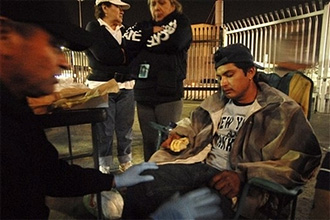 |
 |
 |
 Editorials | Issues | June 2007 Editorials | Issues | June 2007  
Deported Migrants End Up Homeless in Mexican Border Cities
 David Maung - Associated Press David Maung - Associated Press


| | Deported migrants are backlit by lights coming from the US side of the US-Mexico border as they eat food given to them by the humanitarian migrant assistance group Angeles del Desierto, or Desert Angels, near the Tijuana river levee in Tijuana, Mexico, Saturday, June 9, 2007. (AP/David Maung) | 
| | Beto Villasenor, a migrant from Mexico's Michoacan state, receives medical attention from Rafael Hernandez, of the humanitarian migrant assistance group Angeles del Desierto, or Desert Angels, in Tijuana, Mexico, Saturday, June 9, 2007, after Villasenor sprained his ankle while being chased by the US Border Patrol in an attempt to cross into the US illegally. (AP/David Maung) |
Tijuana, Mexico - Mexican border cities are struggling with an influx of migrants deported by the U.S. government, which has been kicking out illegal migrants at record levels, migrant relief groups say.

Many of those deported have spent decades working at restaurants, offices and in the fields from California to North Carolina.

Some return to

Mexico virtually penniless after spending their savings on lawyers fees to fight their deportation orders and wind up living on the tough, crime-ridden streets of border cities like Tijuana, across from San Diego, California, where they must fend off corrupt police, gangs and thieves, migrant groups say.

They survive by washing car windows or doing other odd jobs or by simply begging, and many sleep on a river levee in Tijuana, where humanitarian volunteers bring them food and water.

Deportations have jumped fourfold since 1996, when a new law ordered the immediate expulsion of migrants who return after being deported. Deportations increased further after the U.S. government created the U.S. Immigration and Customs Enforcement, which has a unit focused on deporting illegal migrants who have been in the country for years.

ICE says the U.S. government has returned more than 1 million illegal migrants each year to the Mexican border.

ICE officials say they try to delay deportations for weeks if migrants have U.S.-born children so they can arrange for child care.

In 2004, U.S. officials tried to break migrants' ties with smugglers, whose fees often include several attempts to cross, by putting them across the border far from where they were caught.

The program, however, outraged Texans who said it brought more illegal immigrants from Arizona into their state, and the Mexican government complained migrants were stranded in unfamiliar areas.

Last year, U.S. officials budgeted US$14.2 million for a pilot program that flew as many as 33,900 Mexican migrants to Mexico's heartland rather than leaving them at the border. | 
 | |
 |



